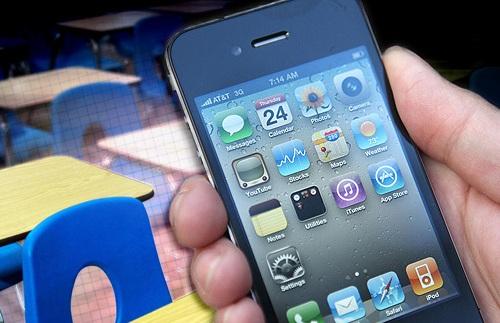
When I was in high school, I felt like I was on my cell phone more than actually paying attention to the lessons. I was always texting, always aware, and always checking to see if I received a new message from a friend. After all, you never know when your best friend might need to meet you in the hallway for moral support, right? Back then most people had basic phones, and the only real smartphone around was the first iPhone. But since then, phones have become much more advanced and I believe could possibly benefit kids in the classroom if used correctly.
My best friend is about to graduate college to become a teacher, and she has actually been studying ways that cell phones could be used from a beneficial standpoint in a classroom setting. She only thought of this after encountering so many problems as an intern with kids in her classroom using cell phones when they weren’t supposed to. At the age of ten, she said more than half the kids in her classroom carry some type of smartphone. Not even a basic flip phone for emergencies, but an all out smartphone. Can you believe that?
She can’t really do utilize any of this research at this time as these kids are only in fourth grade and naturally not everyone has a phone, but she said she wanted to look up some options for future ideas as phones will only get “smarter” as time goes on. So we sat down and researched some ways that phones have already been able to help kids in a classroom setting, and have found quite a bit of usefulness for all types of phones (even if they’re not smartphones).
I’m fairly certain all of us have had those math teachers that tell us “You won’t be able to use a calculator all the time in the real world!” Aha, joke’s on you, condescending teacher! Yes I will! The calculator that comes standard on most cell phones in general is probably the simplest tool that we could use in class. I think I’ve gotten so used to having a calculator on my phone I hardly ever use just a plain old calculator anymore.
Another basic feature that most phones have - a camera - can also be considered useful, not only for snapping trendy angle shots of yourself on those days that you just look too good to not take a picture, but also for taking pictures of slideshows involving notes. If you’re anything like me, your fingers type a lot faster than they write, and I always seemed to have a hard time keeping up with hand writing the important stuff from the notes. Taking a photo of these slides can help students who need a little more time to copy down the notes without the stress of trying to keep up.
Even if your teacher or professor isn’t the type to create slideshows for notes, but instead prefers lectures, you might find that a voice recorder on your phone is very useful for playback. This holds especially true if you have one of those teachers that give lectures as if they’re hosting an auction, and there’s no stopping them until the auction (or lecture) is over. Hopefully you have a voice editing feature where you can slow down their voices, too.
Although these features can be useful to students, one could argue that some students wouldn’t pay attention and would get distracted by the phones' other enticing features (“Hay Kelly, r u goin 2 da futball game afta skoo?” “Gurl plz, I’m tryin 2 learn here!”) but I would be interested to see the results of research studies of students being allowed to use their phones to their advantage in the classroom.
What are your views on phones in the classroom? Would you be for it or against it?
Images via Gizmodo